
STORM SIGNALS
Fall 1998, Vol. 49
CONTENTS

This edition of Storm Signalswas printed by Union Carbide, as a service to the citizens of Southeast Texas and the upper Texas coastal area.
EMWIN USERS WORKSHOP
DEC. 4TH AND 5TH, 1998
HOUSTON, TEXAS
Emergency Managers Weather Information Network
By Gene Hafele
EMWIN is a new and less expensive method to receive weather information directly from the National Weather Service. It can alert you when the NWS issues warnings for your county or give you the forecast for the rivers that are in flood.
The first EMWIN-Users Workshop will be held in Houston, Texas, on Friday, December 4th and Saturday, December 5th.
There is no fee for the Workshop, but all attendees must register. For registration information and updates to the agenda, see the Xencode Internet Web Site at http://www.weathernode.com/emwincon.asp or call Chris Grant at 405-366-6583, extension 141.
AGENDA
The HCAD training facility has complete audio-visual support available. Presenters who plan to use computers in the course of their presentation will have the ability to project the image on five screens. Computer image projection will also be available for the WeatherNode 4.0 software orientation sessions.
Ed Covington from Zephyrus is going to bring a low powered VHF transmitter and retransmit the 9600 baud datastream for the benefit of vendors and presenters who need it to activate their equipment.
This is a great opportunity for Emergency Managers in Southeast Texas to become familiar with EMWIN and see if this system would be useful for your EOC. All of your answers will be answered about this new and upcoming system. This system is available for everyone including Industry... Schools...Government and even the individual citizen.
1998 HURRICANE SEASON
Texas escapes...AGAIN...and sets an all time record!
by Joshua Lichter
With less than a month left in the 1998 Hurricane Season, The Texas coast has been fortunate once again to not receive the wrath of a hurricane. If Texas does not get struck by a hurricane during the month of November (Texas has never been struck by a hurricane in November since records began in 1886), a new all time record will be set. The Texas coast will have gone nine consecutive seasons - 1990 to 1998 - without a visiting hurricane. This will break the previous record of eight consecutive years from 1972 to 1979.
The Atlantic-Caribbean Sea-Gulf of America tropical basin was very active this year, and the Texas coast was unable to avoid two tropical visitors. On August 22nd, Tropical Storm Charley made landfall near Port Aransas and produced heavy rains across portions of the state for the next several days. Rainfall became torrential in the Del Rio area, and flooding resulted in at least 21 deaths - 12 in Texas and 9 in Mexico. One day rainfall totals were as high as 17.03 inches in Del Rio on August 23rd. The Austin-San Antonio National Weather Service Office issued numerous flood warnings for several area rivers well in advance of observed flooding, which likely saved many lives. Significant damage was also observed in the Texas Hill Country's Garner State Park, located west of San Antonio and north of Uvalde. Total damage costs from Charley are still being assessed.
In September, Tropical Storm Frances made landfall just to the northeast of Port Aransas with 65 mph winds. Frances was particularly devastating for the coastal counties of Upper Texas. Severe beach erosion and coastal flooding caused by persistent onshore winds lead to disaster declarations for Harris, Galveston, Brazoria and Matagorda counties. Flood producing rains inundated portion of Harris County on the morning of September 11th which lead to significant damage to many homes and businesses along several area bayous. For more information on Frances, please see the article "Tropical Storm Frances...it was just a Tropical Storm," found in this issue of Storm Signals.
Probably the most significant hurricanes of the 1998 season were Georges and Mitch. Georges cut a path of destruction from its first landfall in the northern Leeward Islands on September 20th to its last strike at Biloxi, Mississippi on September 28th. In between, Georges devastated portions of Puerto Rico and Hispaniola and caused damage in Cuba and the Florida Keys. Georges's sustained winds reached 150 mph - just 5 miles short of reaching Category 5 status on the Saffir-Simpson Hurricane Scale - before reaching the Leeward Islands. Georges lead to more than 300 deaths - mainly in the Caribbean. Please refer to the internet site http://www.ncdc.noaa.gov/ol/reports/georges/georges.html for an excellent summary on the wrath of Georges.
Mitch was the deadliest storm of the season. This hurricane, at its peak intensity, had 180 mph winds, making it a Category 5 hurricane. Mitch bottomed out with a minimum central pressure of 905 millibars...the fourth lowest pressure ever recorded for a hurricane in the Atlantic basin this century. Fortunately, Mitch reached its peak intensity while still offshore. Unfortunately, Mitch gradually made its way to the northern coast of Honduras and stalled. The weakened system produced copious amounts of rainfall over mountainous terrains of Nicaragua and Honduras which lead to devastating flash flooding. The death toll and total damage estimates are still being determined, but many thousands of people were killed by Mitch.
Through the middle of November, there have been 13 named storms this season, 9 of which have reached hurricane status. Three of these hurricanes - Bonnie, Georges and Mitch - were considered major (category 3 or higher). The following preliminary table summarizes the 1998 season. This table is subject to change pending any future storms and updated damage reports. For a more detailed, storm-by-storm summary of the 1998 season, plan on attending the Houston/Galveston National Weather Service 1999 Hurricane Workshop in May.
| NAME | DATES | WIND | PRESSURE | CATEGORY |
|---|---|---|---|---|
| TS Alex | 27 JUL - 3 AUG | 45 knots | 1000 mb | - |
| H Bonnie | 19-30 AUG | 100 | 954 | 3 |
| TS Charley | 21-22 AUG | 50 | 1003 | - |
| H Danielle | 24 AUG - 3 SEP | 90 | 955 | 2 |
| H Earl | 31 AUG - 3 SEP | 85 | 986 | 2 |
| TS Frances | 8-12 SEP | 55 | 990 | - |
| H Georges | 15-29 SEP | 130 | 938 | 4 |
| TS Hermine | 17-20 SEP | 40 | 999 | - |
| H Ivan | 20-27 SEP | 80 | 975 | 1 |
| H Jeanne | 21 SEP - 1 OCT | 90 | 970 | 2 |
| H Karl | 23 - 28 SEP | 90 | 970 | 2 |
| H Lisa | 5 - 9 OCT | 65 | 987 | 1 |
| H Mitch | 21 OCT - 5 NOV | 180 | 905 | 5 |
Note: TS=Tropical Storm; H=Hurricane
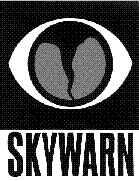
SKYWARN 1999
By Gene Hafele
In 1998 we experienced almost every aspect of weather from severe weather last winter to drought in the summer to Tropical Storm Frances this September and to a major flood this fall. There is no reason to think 1999 will be any different. One of the best ways to make your county and or community better prepared is to establish or enhance your SKYWARN program in 1999.
What is Skywarn? Skywarn is a program sponsored by your National Weather Service Office in conjunction with your local Emergency Management Organizations. It is a group of trained volunteers that watch the skies during severe weather and relay reports back to the local Emergency Management Official, the local law enforcement agency, and/or the National Weather Service. These volunteers provide valuable information to the National Weather Service which helps improve the warning program, thus possibly saving lives and property in the community.
A typical Skywarn program last 2-3 hours. It will help the individual identify the varying types of thunderstorms and what type of severe weather to expect from each type of thunderstorm. But of more importance...you will learn what valuable information should be passed on to the National Weather Service and/or your Emergency Management Office and also what method to use to get that information relayed. You will learn about the NWS operations and how we disseminate information to your community.
If you or your community is interested in sponsoring a Skywarn Program, now is the time to reserve your training session. The Houston/Galveston National Weather Service will be conducting Skywarn classes during the months of January, February, and March to help the Skywarn spotters be prepared for the 1999 Spring Severe Weather Season. The training sessions last 2-3 hours and can be scheduled during the day...in the evening...or even on Saturday to best meet you or your group's schedule.
If your group or community is interested in sponsoring a Skywarn Program in early 1999, please make your reservations now. Call Gene Hafele at 281-337-5074 x228. Regardless of past history, Mother Nature can always throw a curve. We must be prepared for any severe weather outbreak.
Summer of 1998 Heat Wave
by Charles Roeseler
Through September, temperatures remained well above normal across southeast Texas for the fifth consecutive month despite the return of tropical rain. If not for Tropical Storm Frances, September of 1998 would likely have been the warmest September of all time for the cities of Houston and Galveston. Numerous temperature records were again set across the region. The temperature warmed to 95 degrees in Galveston on September 29th. This was the warmest temperature ever recorded on the island for that late in the year. The following chart will display climatological data for Houston, Galveston and College Station for September 1998 compared to normal. A second chart will show the average temperatures and rainfall for the five month period of May through September.
Comparison of September Climatology and 1998 Data| Houston | Galveston | College Station | |
| Sept 1998 Avg High Normal High |
91.1 88.4 |
88.5 84.5 |
90.8 88.4 |
| Sept 1998 Avg Low Normal Low |
73.2 67.9 |
78.8 75.4 |
73.4 68.7 |
| Sept 1998 Avg Daily Normal Daily |
82.2 78.2 |
83.7 80.0 |
82.1 78.6 |
| Sept 1998 CDD* Normal CDD* |
524 396 |
566 450 |
520 408 |
| Sept 1998 Rainfall Normal Rainfall |
10.19 4.89 |
12.87 5.93 |
7.62 4.87 |
May 1998 - September 1998
| Houston | Galveston | College Station | |
| 1998 Avg High 30 Year Avg High |
94.1 89.7 |
87.8 84.9 |
95.5 90.3 |
| 1998 Avg Low 30 Year Avg Low |
72.9 69.5 |
78.2 76.6 |
73.3 70.3 |
| 1998 Rainfall 30 Year Rainfall |
19.14 22.18 |
27.05 22.39 |
12.28 18.06 |
| 1998 CDD* 30 Year CDD* |
2876 2235 |
2676 2409 |
2984 2343 |
* CCD = Cooling Degree Days
Temperatures across southeast Texas averaged 2 to 4 degrees above normal for the month of September and 4 to 5 degrees above normal for the last five months. A cooling degree day (CDD) is the difference between the average daily temperature and a base temperature of 65 degrees. CDDs are used to calculate energy usage. In 1998, CDD averaged between 27 and 28 percent higher than normal. This corresponds to about an increase of about 27 percent in energy usage and a 27 percent increase in utility cost. Not only was it hot, but also a bit more expensive. Hopefully, a change to more seasonal weather will return to southeast Texas this winter.
Tropical Storm Frances...
It was "Just" a Tropical Storm
By Gene Hafele
Synoptic Situation...
On Monday September 7 (Labor Day) a tropical disturbance in the western Gulf of America was increasing the pressure gradient along the Texas coast. A weak cold front had pushed south to near the Red River by Tuesday evening. At 4pm Tuesday the disturbance was upgraded to a Tropical Depression located about 250 miles south of Galveston. On Wednesday morning the cold front had sagged down to a Lufkin to Dallas line with a 1022mb high pressure centered over the Ohio Valley. At 4 PM the depression was upgraded to a Tropical Storm and given the name Frances. Winds along the upper Texas coast were from the ENE 20 to 30 mph with gusts nearing 40 mph. The poorly organized Tropical Storm center of circulation was still located about 250 miles south of Galveston with maximum sustained winds of 40 mph. On Thursday the storm remained disorganized and was located about 190 miles south of Galveston. On Thursday afternoon the storm had deepened and maximum sustained winds had increased to near 60 mph. The surface ridge of high pressure had now shifted to the southeast and was centered over Tennessee. This increased the pressure gradient and the winds along the upper Texas coast. Early Friday morning Frances neared the Texas coast near Port O'Connor. Winds along the upper Texas coast continued at 30 to 40 mph sustained winds with gusts near 50 mph at times. Frances moved inland just southwest of Victoria and remained nearly stationary throughout the day on Friday. On Friday evening Frances began moving to the north northeast. At 7 PM Frances was downgraded to a Tropical Depression as it moved to the northeast of Victoria. At 10 PM the remnants of Frances were located about 65 miles west of Houston and it was longer being tracked by the National Hurricane Center.
Tides....
Most of the damage along the coastal communities can be attributed to the high tides that persisted for nearly two days. The high tides in Galveston Bay also enhanced the flooding problems experienced further inland by the heavy rains. A Coastal Flood Watch was issued Monday night concerning the possibility of high tides beginning on Tuesday with tides expected to run 3 feet above predicted levels. On Tuesday afternoon the Coastal Flood Watch was updated to extend the watch into Wednesday with tides predicted to be 3 to 4 feet above predicted levels by Wednesday afternoon. At 4pm Tuesday Tropical Depression #6 formed in the Gulf of America and a Tropical Storm Warning was issued for the Texas Coast from High Island to Brownsville. The Tropical Storm Warning implies that a Coastal Flood Warning is also in effect. On Wednesday the tide forecast was updated with a forecast of tides 4 to 5 feet above predicted levels expected on Thursday. On Thursday the tide prediction for Friday called for tides increasing to levels of 4 to 6 feet above the predicted levels.
On the beach front at Galveston Pleasure Pier the tides rose above 4 feet above MLLW on Wednesday afternoon (Sept 9) and remained above this level until the Friday afternoon (Sept. 11). The maximum level was reached on Thursday evening when the gauge read around 7 feet above MLLW or about 4.5 feet above the predicted levels. In Galveston Bay a similar event took place. At Eagle Point the tides rose above 4 feet above MLLW on Wednesday evening (September 9) and stayed above this level until after midnight on September 12. The peak height reached was around 5.7 feet above MLLW during the early morning hours of September 10 which is 4.7 feet above the predicted levels.
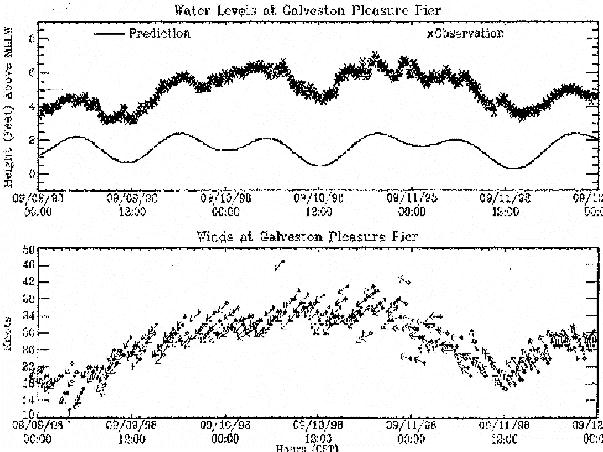 |
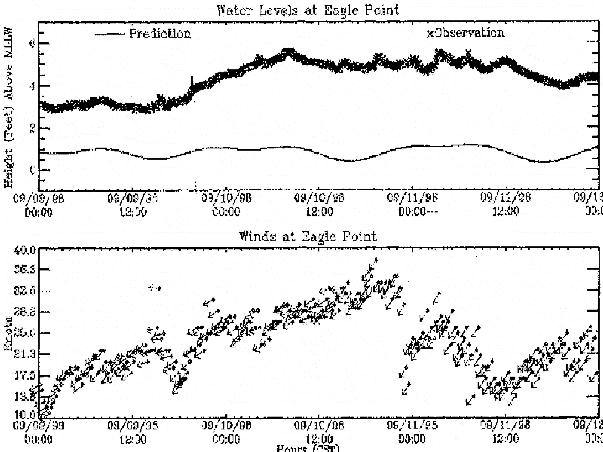 |
Similar conditions were found along the entire upper Texas Coast from High Island to Matagorda and in the inland bays. With tides above 4 feet MLLW for 36 to 48 consecutive hours and winds in excess of 25 mph through the same period led to the destructive waves along the beach front. These destructive waves resulted in most of the dune systems from High Island to Sargent Texas being almost completely destroyed.
Winds and Pressure..
As you can see from the graphs included in this article, winds ranged from 25 to 35 knots (29 - 40 mph) for over 24 hours starting around midnight on the September 10 and continuing til the early morning of September 11. The strongest wind recorded was 47 knots (54 mph) at Galveston Scholes Field around 6pm on Sept. 10. Other peak winds recorded around the area included 46 knots (53 mph) at Palacios and 31 knots (36 mph) at Houston Intercontinental Airport. The lowest atmospheric pressure recorded was at Palacios when the barometer read 29.38 inches at 254 PM on Sept. 11. Galveston recorded 29.48 inches at 529 am Sept. 11.
Rainfall...
Rainfall from Tropical Storm Frances began effecting the coastal areas during the morning on Thursday and conditions slowly spread inland Thursday afternoon and further inland early Friday morning. Over 4 inches of rain fell over all of the Houston/Galveston County Warning area. Over 10 inches of rain was common along the coastal counties of Matagorda...Brazoria...Galveston and Chambers and also over inland counties including Harris...Polk...San Jacinto and Washington. With tides already running 4 to 6 feet above normal the runoff from the rains was not able to easily runoff into the bays thus resulting in more widespread flooding of inland creeks and bayous especially early Friday morning. See the attached rainfall chart showing the areal extent of rainfall across southeast Texas.
River and Bayou Flooding...
September was an active month across the HSA with Tropical Storm Frances dumping 4 to 6 inches of rain over the region. Large areas received 8 to 10 inches of rain with some areas receiving more than 12 inches. The result was significant flooding in many areas. Flooding was exacerbated in many areas by tides 4 to 6 feet above normal. Significant rises occurred on the San Bernard River in Brazoria County from above Sweeny to the mouth on September 9th with flood stage exceeded on September 10th. This rise was mainly due to strong tidal influence. Significant rains began on September 10th and continued through the 12th. The majority of the rain occurred during the morning hours of September 11th as Frances made landfall.
By daybreak September 11th significant flooding was occurring in Harris County and the City of Houston. Homes in Jersey Village and Woodland Trails in northwest Houston along White Oak Bayou were flooding by 6:00 am. Most subdivisions along White Oak Bayou experienced house flooding. Homes were also flooded on Halls Bayou above I-45, on Brays Bayou at Lawndale near the confluence with the Houston Ship Channel, and on Armand Bayou near Spencer Highway in Pasadena. I-10 between the West Loop and downtown Houston and I-45 near North Main Street were closed by 9:00 am due to flooding from Buffalo and White Oak Bayous. State Highway 288 was closed due to flooding from Brays Bayou. In all more than 1400 homes and businesses were damaged or destroyed in this event.
In Brazoria County Chocolate Bayou near Alvin exceeded its banks in the channel above FM 1462 to the mouth at Chocolate Bay. Several minor roads were impacted by this flooding.
Significant flooding occurred on the San Bernard River above U.S. Highway 59 near Kendalton to the mouth. Primary flooding above FM 442 near Boling was due to backwater on the tributaries of Peach and West Bernard Creeks in Wharton County. While no homes were reported flooded several roads in the El Lobo subdivision were inundated. A combination of strong tidal influence and heavy rain produced the rise in the channel above Sweeny to the mouth. While low lying areas along the river were flooded the most significant impact was on barge traffic at the Phillips Petroleum Facility.
The Tres Palacios River in Matagorda County began rising at the rate of one foot an hour during the evening hours of September 10th resulting in moderate lowland flooding above State Highway 71 near Midfield to the mouth at Tres Palacios Bay. Significant backwater up Juanita Creek, about one mile upstream from the gaging station at FM 456, was also noted. Several farm to market and county roads in Matagorda County were inundated by this flood. There were no reports of homes flooded. However, several areas were isolated due to the flooded roadways.
Flooding on East Mustang Creek near Louise in Wharton County closed FM 647 for several hours on September 12th. Secondary and minor roads near the creek were also inundated.
Several small, ungaged watersheds in Chambers, Galveston, Brazoria, Matagorda, Fort Bend, and Wharton Counties flooded. This resulted in the closing of many farm to market and county roads with several homes and subdivisions threatened. These included Dickinson Bayou in Galveston County, Oyster Creek in Brazoria County and Caney Creek in Matagorda County.
Water had receded on all but the San Bernard and Tres Palacios Rivers by the afternoon of September 12th. There were no deaths or serious injuries due to river flooding associated with this event. Galveston, Harris, Brazoria, and Matagorda Counties were declared disaster areas.
Impact and Damage...
Major impact and resultant damage occurred in Galveston, Harris, Brazoria and Matagorda counties of Texas. All four of these counties received a Presidential Disaster Declaration to help in the relief and recovery efforts. In these four counties total damage exceeded $286 million dollars. Most of this damage was along the coast and around Galveston Bay where high tides and winds destroyed dunes and personal property. Nearly 100 single family homes were destroyed along the upper Texas coast by the high tides and battering waves. Other damage was a result of inland flooding due to heavy rains mainly in Harris county along White Oak and Buffalo Bayous.
There were only 3 deaths that can be attributed to Tropical Storm Frances. A father and daughter drowned on Galveston Island while swimming in the surf during the day Monday. The third death occurred on Wednesday when a surfer drowned on the beaches of Surfside in Brazoria county while surfing the large waves.
Summary...
Tropical Storm Frances brought home how vulnerable the Texas Coast is to tropical weather systems even if they do not achieve hurricane strength. Since Frances never achieved Hurricane strength the citizens along the upper Texas Coast never realized the damage that could result from "Just a Tropical Storm". With a long siege of high tides coupled with tropical storm force winds it was very similar to having a strong category one hurricane. The rains that accompanied the storm were fairly normal for a slow moving topical sorm but flooding was aggravated by the high tides that were already in place when the heavy rains began.
We have not had a hurricane along the Texas Coast since 1989 and have forgotten the effects a hurricane can bring to our coastline. With roads that flood at tides of 4 to 6 feet evacuation of some communities at a very early stage becomes a necessity. We hope the citizens of the Upper Texas Coast use the lessons we have learned from Tropical Storm Frances and apply them when a real hurricane visits the Upper Texas Coast.
| RIVER AND STATION |
FLOOD ABOVE STAGE (Feet) |
FLOOD STAGES (Dates) |
CREST STAGE (Feet) |
DATE | |
| FROM | TO | ||||
| Cypress Creek near Westfield |
21.0 | 9/11/98 | 9/18/98 | 21.50 | 9/11/98 |
| Cypress Creek near Westfield |
28.0 | 9/11/98 | 9/12/98 | 33.53 | 9/11/98 |
| White Oak Bayou at Heights Blvd |
41.0 | 9/11/98 | 9/11/98 | 47.06 | 9/11/98 |
| Buffalo Bayou at Shepherd Drive |
23.0 | 9/11/98 | 9/12/98 | 36.46 | 9/11/98 |
| Clear Creek at FM 528 | 12.0 | 9/11/98 | 9/12/98 | 13.68 | 9/11/98 |
| Chocolate Bayou near Alvin |
24.0 | 9/11/98 | 9/13/98 | 29.99 | 9/12/98 |
| San Bernard River near Boling |
18.0 | 9/11/98 | 9/22/98 | 26.31 28.55 |
9/12/98 9/16/98 |
| near Sweeny | 16.0 | 9/10/98 | 9/20/98 | 23.60 | 9/11/98 |
| Tres Palacios River near Midfield |
24.0 | 9/10/98 9/16/98 |
9/14/98 9/17/98 |
30.69 24.20 |
9/11/98 9/16/98 |
| East Mustang Creek near Louise | 19.0 | 9/10/98 | 9/12/98 | 21.95 | 9/11/98 |
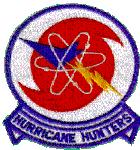
Hurricane Hunters Become the Hunted
By Dan Darbe
For nine days Hurricane Georges and the Air Force Reservists assigned to the Hurricane Hunters of the 53rd Reconnaissance Squadron did battle from the western Atlantic, through the Caribbean, and across the Gulf of America. The Squadron first began to fly Hurricane Georges on September 19th out of a forward operating base located on the island of St. Croix in the Virgin Islands. The first mission into Georges found sustained winds of 146 knots with gust of 166 knots in the northeast eye wall with the minimum sea level pressure rapidly dropping to 937 millibars. This made Georges a strong category 4 hurricane with gust well into the category 5 range. The well defined eye seen on satellite images was much more impressive up close as the crew described the classic stadium effect as being so good, you could count the bleachers.
As the storm beared down on the Caribbean islands, the Hurricane Hunters became the hunted, and on September 20th, were forced to flee St. Croix for a much safer haven on the island of Barbados. For the next several days, the crews tracked Georges, now a strong category 3 hurricane, across some of the more well known and heavily populated islands of Antique, St. Croix, Puerto Rico, Dominican Republic and Cuba as it headed for the Keys in the southeastern Gulf of America. The hurricane showed no mercy as it brought devastating winds and rain to the islands, killing hundreds of people and leaving thousands homeless. The storm played havoc on the Hurricane Hunters. Numerous planes returned from their 10 to 12 hour missions with the loss of one or even two engines from damages caused by the combination of large hail, torrential rains, and strong winds being slammed into the oil coolers as the planes battled their way through the powerful 20 mile wide eye wall. As the storm tracked across Cuba, the Hurricane Hunters quickly redeployed back to Keesler AFB in Biloxi, Mississippi and prepared to do battle once again, but this time over the Gulf of America. After several days of flying Georges over the Gulf, it became clear the Hurricane Hunters were once again the hunted and were forced to scramble their ten WC-130 aircraft to a safer location, this time Ellington Field just south of Houston. From there the crews flew Georges as it slammed into the north central gulf coast, and ironically, watched the storm make a direct hit on their own homes and families in the Biloxi area. The last mission on Georges was flown during the early morning hours of September 28th as the eye slowly tracked across Biloxi, causing widespread flooding and wind damage to areas from New Orleans to well east of Mobile, Alabama.
Over a nine day period, the Hurricane Hunters flew 17 direct missions and 74 support missions, providing the National Hurricane Center with vital information around-the-clock on the strength and progression of Hurricane Georges. All total, the crews spent 166 hours in and around the storms fury and witnessed the third most destructive hurricane on record lay havoc from the Carribean to their own home town, as the families and crews of the world famous Hurricane Hunters became the hunted.
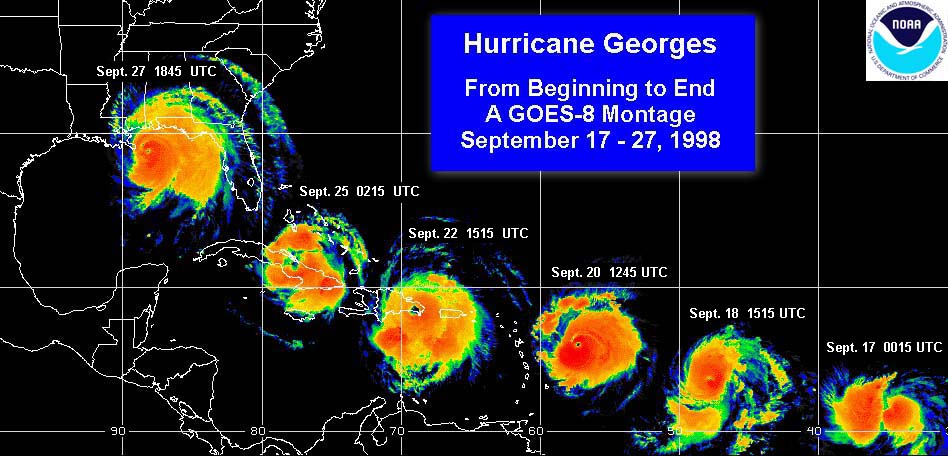
http://www.hurricanehunters.com
|
Skywarn is the National Weather Service (NWS) program of trained volunteer severe weather spotters. Skywarn Spotters support their local community and government by providing the NWS and there local emergency managers with timely and accurate severe weather reports. These reports, when integrated with modern NWS technology, are used to inform communities of the proper actions to take as severe weather threatens. Texas SKYWARN http://www.skywarn-texas.org/
Houston SKYWARN http://members.aol.com/JWRONG/index3.html
|
STAFF SPOTLIGHT
---Joshua Lichter---

Name: Joshua Lichter
Office: NWS Houston/Galveston (HGX), League City, TX
Position: Senior Forecaster
Favorite Movie: "Apollo 13"
Personal Info:
Hometown: North Miami Beach, FL
Birthday: August 25
Other: Single with no cats
Favorite Color(s): Garnet and Gold
Duties/Career Highlights/Other
What has been you most memorable weather event at NWSO HGX?
October 1994 Floods
What is your favorite type of weather?
Hurricanes and summer heat; "90 degrees is just about right and 60 degrees is way too cold!"
What is your favorite task/duty at work?
Forecasting and/or eating all the Milky Ways at the snack bar
On average, how much TV do you watch per week? Favorite TV Shows?
Over 50 hours; "China Beach" and "ER"
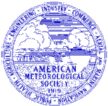 Houston Chapter of the American Meteorological Society
Houston Chapter of the American Meteorological Society
by Robert Van Hoven
The September 17 meeting was held at the Spaghetti Warehouse in downtown Houston. The guest speaker was Don Galloway of the Texas Forest Service. Don talked about "Fire Behavior, Weather and Fuels". The presentation by Don showed some interesting facts including - 90 percent of forest fires are caused by people. Compared to summer when the air mass is usually quite moist, forest fire potential can be quite high in winter when air moisture levels are relatively low, and combined with sustained periods of little or no rain. The "dryness" of the vegetation obviously play a very important role in the fire weather forecasting. To sum it up, the meeting was very informative. The spaghetti and lasagna with garlic bread was delicious.
The October 15 meeting was held at the National Weather Service office in League City. Chapter members enjoyed their dinner at Bradley's Brewery and Restaurant in Clear Lake. The guest speaker was Lance Wood. Lance is a senior forecaster at the weather office and he is also the AWIPS (Advance Weather Interactive Processing System) focal point. Lance provided an excellent presentation on AWIPS. Afterwards, he demonstrated the capabilities of the system.
The next meeting will be on Thursday, November 19. The meeting will be held at the Center Weather Service Unit (CWSU) which is located at the FAA Air Routing Traffic Control Center near Bush Intercontinental Airport. Vince Carreras, who is the Meteorologist-in-Charge of the CWSU, will provide a presentation about their operations. Please check the Houston AMS website for more details concerning this upcoming meeting.
Winter Weather Information
Extreme Cold
Extreme cold often accompanies a winter storm or is left in its wake. Prolonged exposure tothe cold can cause frostbite or hypothermia and become life-threatening. Infants andelderly people are most susceptible. What constitutes extreme cold and its effect varies across different areas of the United States. In areas unaccustomed to winter weather, nearfreezing temperatures are considered "extreme cold." Freezing temperatures can causesevere damage to citrus fruit crops and other vegetation. Pipes may freeze and burst inhomes that are poorly insulated or without heat. In the north, below zero temperatures maybe considered as "extreme cold." Long cold spells can cause rivers to freeze, disruptingshipping. Ice jams may form and lead to flooding.
Ice Storms
Heavy accumulations of ice can bring down trees, electrical wires, telephone poles and lines, and communication towers. Communications and power can be disrupted for days while utility companies work to repair the extensive damage. Even small accumulations of ice may cause extreme hazards to motorists and pedestrians.
Winter Precipitation
Snow Flurries - Light snow falling for short durations. No accumulation or light dusting is all that is expected.
Sleet - Rain drops that freeze into ice pellets before reaching the ground. Sleet usually bounces when hitting a surface and does not stick to objects. However, it can accumulate like snow and cause a hazard to motorists.
Freezing Rain - Rain that falls onto a surface with a temperature below freezing. This causes it to freeze to surfaces, such as trees, cars, and roads, forming a coating or glaze of ice. Even small accumulations of ice can cause a significant hazard.
Winter Regions - Along the Gulf Coast and Southeast...This region is generally unaccustomed to snow, ice, and freezing temperatures. Once in a while, cold air penetrates south across Texas and Florida, into the Gulf of America. Temperatures fall below freezing killing tender vegetation, such as flowering plants and the citrus fruit crop. Wet snow and ice rapidly accumulate on trees with leaves, causing the branches to snap under the load. Motorists are generally unaccustomed to driving on slick roads and traffic accidents increase. Some buildings are poorly insulated or lack heat altogether. Local municipalities may not have available snow removal equipment or treatments, such as sand or salt, for icy roads.
Winter Storm Facts
COLD
FROSTBITE
Frostbite is damage to body tissue caused by that tissue being frozen. Frostbite causes a loss of feeling and a white or pale appearance in extremities, such as fingers, toes, ear lobes, or the tip of the nose. If symptoms are detected, get medical help immediately! If you must wait for help, slowly rewarm affected areas. However, if the person is also showing signs of hypothermia, warm the body core before the extremities.
HYPOTHERMIA: LOW BODY TEMPERATURE
Warning signs - uncontrollable shivering, memory loss, disorientation, incoherence, slurred speech ,drowsiness, and apparent exhaustion.
Detection - Take the person's temperature. If below 95F (35C),immediately seek medical care! If medical care is not available, begin warming the person slowly. Warm the body core first. If needed, use your own body heat to help. Get the person into dry clothing, and wrap them in a warm blanket covering the head and neck. Do not give the person alcohol, drugs, coffee, or any hot beverage or food; warm broth is better. Do not warm extremities (arms and legs) first! This drives the cold blood toward the heart and can lead to heart failure.
WIND CHILL
The wind chill is based on the rate of heat loss from exposed skin caused by combined effects of wind and cold. As the wind increases, heat is carried away from the body at an accelerated rate, driving down the body temperature. Animals are also affected by wind chill.
AVOID OVEREXERTION, such as shoveling heavy snow, pushing a car, or walking in deep snow. The strain from the cold and the hard labor may cause a heart attack. Sweating could lead to a chill and hypothermia.
When CAUGHT in a Winter Storm...
KEEP AHEAD OF THE STORM by listening to NOAA Weather Radio, commercial radio, and television for the latest winter storm watches, warnings, and advisories.
What to Listen For...
WINTER STORM WATCH:
Severe winter conditions, such as heavy snow and/or ice, are possible within the next day or two. Prepare now!
WINTER STORM WARNING:
Severe winter conditions have begun or are about to begin in your area. Stay indoors!
BLIZZARD WARNING:
Snow and strong winds will combine to produce a blinding snow (near zero visibility), deep drifts, and life-threatening wind chill. Seek refuge immediately!
WINTER WEATHER ADVISORY:
Winter weather conditions are expected to cause significant inconveniences and may be hazardous. If caution is exercised, these situations should not become life- threatening. The greatest hazard is often to motorists.
FROST/FREEZE WARNING:
Below freezing temperatures are expected and may cause significant damage to plants, crops, or fruit trees. In areas unaccustomed to freezing temperatures, people who have homes without heat need to take added precautions.
BE PREPARED... Before the Storm Strikes
DRESS TO FIT THE SEASON.
Wear loose-fitting, light-weight, warm clothing in several layers. Trapped air insulates. Layers can be removed to avoid perspiration and subsequent chill. Outer garments should be tightly woven, water repellent, and hooded. Wear a hat. Half your body heat loss can be from the head. Cover your mouth to protect your lungs from extreme cold. Mittens, snug at the wrist, are better than gloves. Try to stay dry.
FAMILY DISASTER PLAN
Families should be prepared for all hazards that affect their area and themselves. NOAA's National Weather Service, the Federal Emergency Management Agency, and the American Red Cross urge each family to develop a family disaster plan. Where will your family be when disaster strikes? They could be anywhere at work, at school, or in the car. How will you find each other? Will you know if your children are safe? Disasters may force you to evacuate your neighborhood or confine you to your home. What would you do if basic services - water, gas, electricity or telephones - were cut off?
| The NWS maintains the largest meteorological telecommunications switching center in the world, sending and receiving 400,000 meteorological bulletins each day. |